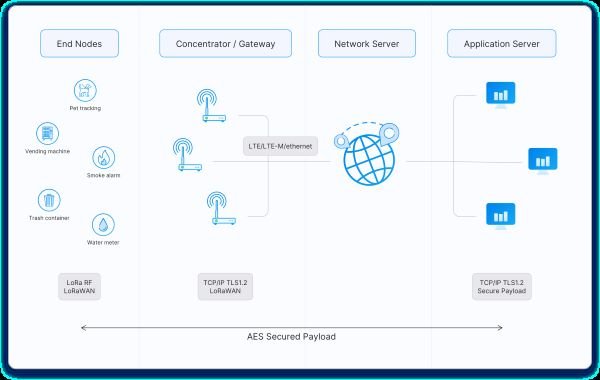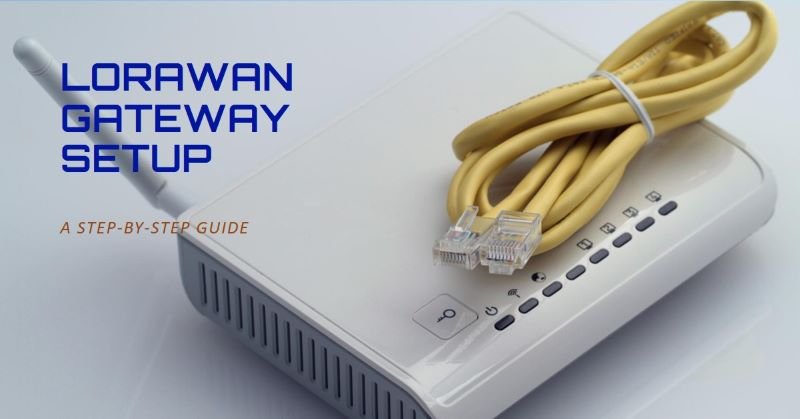LoRaWAN Gateways Explained: Setup, Operation and Real World Applications
Introduction
In the rapidly evolving world of technology, the Internet of Things (IoT) has emerged as a revolutionary concept. It refers to the network of interconnected devices that can communicate and share data with each other. One of the key technologies that enable the functioning of IoT is LoRaWAN.
LoRaWAN, short for Long Range Wide Area Network, is a low-power wireless communication protocol specifically designed for IoT devices. It provides long-range connectivity and low power consumption, making it ideal for applications that require devices to be deployed in remote locations or areas with limited infrastructure.
LoRaWAN gateways are an essential component of the LoRaWAN network architecture. They act as intermediaries between the end-devices and the network server, facilitating the communication between the two. When an IoT device wants to transmit data, it sends the information to the nearest LoRaWAN gateway within its range. The gateway receives the data and forwards it to the network server, which then processes and routes the data to the appropriate destination.
Understanding LoraWan
LoRaWAN is a wireless communication protocol designed specifically for long-range, low-power IoT (Internet of Things) devices. It enables these devices to connect and communicate with each other and with the internet, allowing for seamless integration and data exchange in various applications. LoRaWAN operates on the principle of a star-of-stars network topology. The network consists of three key components: end-devices, gateways, and network servers.
Let’s explore the main components of a LoRaWAN network:

- End-devices: These are IoT gadgets or sensors that collect and send data. They’re usually battery-powered and consume low power. End-devices fall into three classes: Class A, Class B, and Class C.
- Gateways: Acting as go-betweens, gateways link end-devices with the network server. They collect data from end-devices and send it to the network server for processing.
- Network Servers: These manage the LoRaWAN network. They handle tasks like authentication, encryption, and routing of data between end-devices and application servers.
LoRaWAN devices are categorized into three classes: Class A features low power with periodic data transmission; Class B includes scheduled listening windows for efficient downlink communication; and Class C offers continuous listening windows, ideal for immediate downlink communication in low-latency applications.
What is a LoRaWan Gateway?
LoRaWAN gateway is a crucial component in a LoRaWAN network architecture. It acts as a bridge between the end devices and the network server, enabling communication between them. The gateway receives data from the end devices, such as sensors or trackers and forwards it to the network server for processing and analysis.
The primary purpose of a LoRaWAN gateway is to extend the range and coverage of a LoRaWAN network. It receives the signals from the end devices, which typically have limited transmission power, and amplifies and relays them to the network server. This allows devices located far away from the server to communicate effectively, even in remote or challenging environments.
Components of LoRaWAN Gateway
A LoRaWAN gateway consists of several key components that work together to facilitate communication within the network. These components include:
- The radio module is responsible for receiving and transmitting signals in the LoRaWAN frequency band. It acts as a receiver for incoming data from the end devices and as a transmitter for sending data to the network server. The radio module is designed to operate on the specific frequencies and modulation schemes used by LoRaWAN technology.
- A microcontroller is the brain of the LoRaWAN gateway. It controls the operation of the gateway, manages the communication with the network server, and handles the processing of data. The microcontroller is responsible for tasks such as packet routing, encryption/decryption, and error checking. It ensures that the data received from the end devices is properly formatted and forwarded to the network server.
- A network connection is essential for the LoRaWAN gateway to communicate with the network server. It can be either wired or wireless, depending on the deployment scenario. The gateway needs a reliable and stable network connection to transmit the data packets to the server. This connection can be established through Ethernet, Wi-Fi, or cellular networks, depending on the available infrastructure.
- The antenna(s) of a LoRaWAN gateway are responsible for transmitting and receiving signals. They play a crucial role in ensuring the range and coverage of the gateway. The antennas are designed to operate on the specific frequency bands used by LoRaWAN technology. Depending on the deployment scenario, a gateway may have one or multiple antennas to optimize signal reception and transmission.
How Does a LoRaWAN Gateway Work?
A LoRaWAN gateway operates on the principle of receiving and forwarding radio signals. When an end-device transmits data, it uses the LoRa modulation scheme to encode the information onto a radio signal. This signal is then received by the gateway, which acts as a receiver.
The gateway is equipped with one or more antennas that capture the radio signals sent by the end-devices. These signals are then demodulated and decoded by the gateway’s hardware, extracting the original data transmitted by the end-devices. Once the data is extracted, the gateway forwards it to the network server. The network server is responsible for processing the data, managing the LoRaWAN network, and facilitating communication between end-devices and applications.
Role of the Gateway in Receiving LoRaWAN Signals
The gateway plays a crucial role in receiving LoRaWAN signals from end-devices. It acts as a receiver, capturing the radio signals transmitted by the end-devices. The gateway’s antennas are strategically positioned to ensure optimal signal reception. When an end-device transmits data, it uses a specific frequency and spreading factor. The gateway must be configured to listen on the same frequency and spreading factor to receive the signal successfully. This allows the gateway to receive signals from multiple end-devices simultaneously, as long as they are using the same frequency and spreading factor.
Once the gateway receives the signals, it demodulates and decodes them, extracting the original data transmitted by the end-devices. The gateway then forwards this data to the network server for further processing.
Handling Multiple Channels and Spreading Factors
A LoRaWAN gateway is designed to handle multiple channels and spreading factors for efficient communication. This allows it to support a large number of end-devices within its coverage area.
- Channels refer to the specific frequencies on which the gateway listens for LoRaWAN signals. By operating on multiple channels, the gateway can receive signals from different end-devices simultaneously, even if they are using different frequencies.
- Spreading factors, on the other hand, determine the rate at which data is transmitted and the range over which it can be received. Lower spreading factors result in higher data rates but shorter range, while higher spreading factors provide longer range but lower data rates.
- The gateway must be configured to support the same set of channels and spreading factors as the end-devices within its coverage area. This ensures that the gateway can receive signals from all the end-devices and forward them to the network server.
By efficiently managing multiple channels and spreading factors, the gateway enables seamless communication between the end-devices and the network server. This allows for reliable and scalable LoRaWAN deployments.
Setting Up a LoRaWAN Gateway: A Step-by-Step Guide
Let’s see the step-by-step process of hardware installation, configuration of network settings and connection to the network server. We will also provide tips for optimizing gateway placement and antenna orientation for optimal performance.

Hardware Installation
The first step in setting up a LoRaWAN gateway is to install the necessary hardware. Here are the basic steps:
- Choose a suitable location for your gateway. It should be placed in an elevated position, away from obstructions that may block the signal.
- Connect the gateway to a power source using the provided power adapter.
- Connect the gateway to your internet router using an Ethernet cable.
- Check the LED lights on the gateway to ensure it is receiving power and connected to the internet.
Configuration of Network Settings
Once the hardware installation is complete, the next step is to configure the network settings of your LoRaWAN gateway. Here’s how:
- Access the gateway’s configuration interface by entering its IP address into a web browser.
- Log in to the configuration interface using the default username and password provided in the gateway’s documentation.
- Configure the network settings, including the gateway’s IP address, subnet mask, default gateway, and DNS server.
- Save the changes and restart the gateway to apply the new network settings.
Connection to the Network Server
After configuring the network settings, the final step is to connect your LoRaWAN gateway to the network server. Follow these steps:
- Obtain the necessary credentials from your network server provider, including the server address, port number, and gateway ID.
- Access the gateway’s configuration interface and navigate to the LoRaWAN settings.
- Enter the server address, port number, and gateway ID provided by your network server provider.
- Save the changes and restart the gateway to establish the connection to the network server.
Tips for Optimizing Gateway Placement and Antenna Orientation
To ensure optimal performance of your LoRaWAN gateway, it is important to consider the placement and antenna orientation. Here are some tips:
- Place the gateway in an elevated position, such as on a rooftop or high shelf, to minimize obstructions and maximize signal coverage.
- Avoid placing the gateway near large metal objects or other sources of interference, as they can degrade the signal quality.
- Ensure that the gateway’s antenna is positioned vertically for optimal performance.
- Consider using an external antenna for improved signal reception, especially if the gateway is located in a challenging environment.
- Regularly monitor the gateway’s performance and signal strength to identify any potential issues and make necessary adjustments.
By following these steps and considering the tips provided, you should be able to successfully set up a LoRaWAN gateway and optimize its performance.
The Applications of LoRaWAN Gateways
Let’s explore some of the real-world applications where LoRaWAN gateways are being used and discuss successful deployments and case studies that highlight the benefits of this technology in various industries.
- Smart Cities: By deploying a network of gateways throughout a city, various IoT devices can be connected and monitored, enabling the collection of valuable data for better city management. For example, smart parking systems can be implemented using LoRaWAN gateways to monitor parking spaces in real-time, allowing drivers to easily find available parking spots.
- Industrial IoT: By connecting sensors and devices to a LoRaWAN network, industries can gather real-time data on various parameters such as temperature, humidity, pressure, and vibration. This data can be used for predictive maintenance, optimizing energy consumption, and improving overall operational efficiency. For example, in a manufacturing plant, LoRaWAN gateways can be used to monitor the health of machinery, detect anomalies, and schedule maintenance activities proactively, thereby reducing downtime and increasing productivity.
- Agriculture: By connecting soil moisture sensors, weather stations, and other IoT devices to a LoRaWAN network, farmers can gather data on soil conditions, weather patterns, and crop health. This data can help farmers make informed decisions about irrigation, fertilization, and pest control, leading to improved crop yields and reduced resource wastage.
- Environmental Monitoring: Another area where LoRaWAN gateways are being extensively used is environmental monitoring. By deploying gateways in remote areas, researchers and environmental agencies can collect data on air quality, water quality, noise levels, and other environmental parameters. This data can help in the early detection of pollution, identification of sources, and implementation of appropriate mitigation measures.
Now, let’s take a look at some successful deployments and case studies that highlight the benefits of LoRaWAN gateways in these various industries.
Successful Deployments and Case Studies
Smart City: Barcelona, Spain
In Barcelona, LoRaWAN gateways have been deployed to create a city-wide IoT network. This network has enabled the implementation of various smart city applications, including smart parking, waste management, and environmental monitoring. By using LoRaWAN gateways, Barcelona has been able to optimize parking space utilization, reduce waste collection costs, and monitor air quality in real-time, leading to a more sustainable and livable city.
Industrial IoT: Shell Chemicals, Singapore
Shell Chemicals in Singapore has implemented a LoRaWAN-based IoT solution to monitor the condition of critical equipment in their manufacturing plant. By connecting sensors to LoRaWAN gateways, they are able to collect data on temperature, vibration, and other parameters, allowing them to detect potential equipment failures in advance and schedule maintenance activities proactively. This has resulted in a significant reduction in downtime and maintenance costs, as well as improved overall plant efficiency.
Agriculture: Netafim, Israel
Netafim, an Israeli company specializing in drip irrigation systems, has integrated LoRaWAN gateways into their smart irrigation solution. By connecting soil moisture sensors and weather stations to a LoRaWAN network, they are able to provide farmers with real-time information on soil moisture levels and weather conditions. This enables farmers to optimize irrigation schedules, reduce water consumption, and improve crop yields. Netafim’s smart irrigation solution has been successfully deployed in various countries, helping farmers increase their productivity while conserving water resources.
Environmental Monitoring: The Things Network
The Things Network, a global community-driven LoRaWAN network, has enabled numerous environmental monitoring projects around the world. For example, in the Netherlands, LoRaWAN gateways have been deployed to monitor air quality in urban areas, providing citizens with real-time information on pollution levels. In Australia, LoRaWAN gateways have been used to monitor water quality in rivers and lakes, helping to protect aquatic ecosystems. These projects demonstrate the versatility and effectiveness of LoRaWAN gateways in environmental monitoring applications.
Challenges and Considerations
Deploying LoRaWAN gateways can bring numerous benefits to organizations, but it’s important to be aware of the potential challenges and limitations that may arise. By understanding these challenges upfront, you can proactively address them and ensure a successful deployment.
1. Network Coverage
One of the primary challenges when deploying LoRaWAN gateways is ensuring adequate network coverage. LoRaWAN operates in the sub-GHz frequency band, which allows for long-range communication. However, the range can still be limited, especially in urban environments with many buildings and obstacles.
To mitigate this challenge, it’s crucial to conduct a thorough site survey before deploying gateways. This survey should identify potential obstacles such as buildings, trees, and other structures that may hinder signal propagation. By strategically placing gateways in areas with minimal obstructions, you can maximize network coverage.
2. Interference
Interference from other devices operating in the same frequency band can also pose a challenge for LoRaWAN gateways. This interference can degrade the quality of communication and impact the overall performance of the network.
To address this challenge, it’s important to select the appropriate frequency band for your LoRaWAN deployment. Different regions have different regulations regarding frequency bands, so ensure compliance with local regulations. Additionally, implementing techniques such as frequency hopping and spread spectrum modulation can help mitigate interference and improve network reliability.
3. Security Concerns
Security is a critical consideration when deploying LoRaWAN gateways. As gateways act as the bridge between end devices and the network server, they are potential targets for malicious attacks.
To enhance security, it’s essential to implement robust authentication and encryption mechanisms. This includes using secure protocols for communication between gateways and network servers, implementing strong access controls, and regularly updating firmware to address any known vulnerabilities. Additionally, physical security measures such as securing gateway installations and monitoring for any unauthorized access are also crucial.
Final Words
LoRaWAN gateways plays an imp. role in enabling the widespread adoption of IoT solutions. Their ability to provide long-range, low-power connectivity makes them an ideal choice for various industries and applications. By leveraging LoRaWAN gateways, businesses can gather valuable data from sensors and devices deployed in different locations, enabling them to make informed decisions, optimize operations, and improve efficiency. Whether it’s monitoring environmental conditions, tracking assets, or managing energy consumption, LoRaWAN gateways provide the connectivity needed to unlock the full potential of IoT.
Furthermore, the cost-effectiveness of LoRaWAN gateways makes them an attractive option for organizations looking to implement IoT solutions on a larger scale. With fewer gateways required to cover a wide area, the overall deployment and maintenance costs are significantly reduced, making it feasible to implement IoT projects even with limited budgets.








